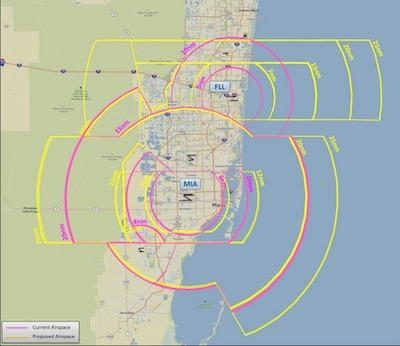The Plan Will Not Change Existing Flight Paths Or The Altitudes That Aircraft Currently Fly
The FAA is proposing to modify the airspace over South Florida to enhance safety. The plan will not change existing flight paths or the altitudes that aircraft currently fly, and it will not result in more flights over the area, the agency says. The graphic depicts the details of the proposed changes.

The proposal would expand the airspace where air traffic controllers track flights and communicate with pilots, which is operating on Instrument Flight Rules (IFR). It increases safety by ensuring that all flights including aircraft operating on Visual Flight Rules (VFR) close to Fort Lauderdale-Hollywood (KFLL) and Miami (KMIA) international airports are under direct air traffic control.
The FAA categorizes the airspace surrounding KMIA as “Class B,” the most restrictive airspace around the busiest airports in the country. KMIA Class B airspace extends to 20 nautical miles around the airport up to 7,000 feet in altitude. The proposal would expand the Class B airspace out to 25 nautical miles east and west of the airport. The top or “ceiling” of the controlled airspace will remain at 7,000 feet. The bottom or “floor” of the Class B airspace gradually increases from the surface to 4000 feet as it extends farther from the airport.
The airspace around KFLL is “Class C,” which is less restrictive, but highly controlled. The KFLL Class C airspace extends to 10 nautical miles up to 4,000 feet in altitude. The proposal would extend the Class C airspace to 25 nautical miles to the east and 20 nautical miles to the west. The ceiling remains at 4,000 feet and the floor gradually increases from the surface to 3,000 feet as the airspace extends farther from the airport.
Aircraft that are flying VFR may fly under or around the Class B and C airspace without requiring air traffic control service.
The plan is not part of the FAA’s South-Central Florida Metroplex, which aims to replace dozens of existing flight procedures with satellite-based routes, enhancing safety and efficiency of flights over the state.
The agency will hold a workshop on the proposal from 3 to 5 p.m., June 12, 2019, at Broward College South Campus, Building 69, Room 133; 7200 Pines Blvd., Pembroke Pines, FL, 33024. Attendees may submit comments at the workshop and by email no later than Aug. 11, 2019.
The FAA changes airspace through the federal rulemaking process. After the comment period closes, we will consolidate and review the comments and incorporate modifications into the final proposal. We anticipate issuing a Notice of Proposed Rulemaking (NPRM) in 2020. We will consider public comments on the NPRM, and publish a final rule that officially will modify the airspace.
The "National Environmental Policy Act of 1969" (NEPA) requires the FAA to identify and publicly disclose any potential environmental impacts of the proposed airspace modifications. We will conduct an environmental review and offer the public the opportunity to comment on the proposal again during the environmental process.
(Source: FAA. Graphic provided)
 ANN's Daily Aero-Linx (12.03.25)
ANN's Daily Aero-Linx (12.03.25) ANN's Daily Aero-Term (12.03.25): CrewMember (UAS)
ANN's Daily Aero-Term (12.03.25): CrewMember (UAS) NTSB Prelim: Maule M-7-235A
NTSB Prelim: Maule M-7-235A Airborne-Flight Training 12.04.25: Ldg Fee Danger, Av Mental Health, PC-7 MKX
Airborne-Flight Training 12.04.25: Ldg Fee Danger, Av Mental Health, PC-7 MKX Aero-News: Quote of the Day (12.04.25)
Aero-News: Quote of the Day (12.04.25)



